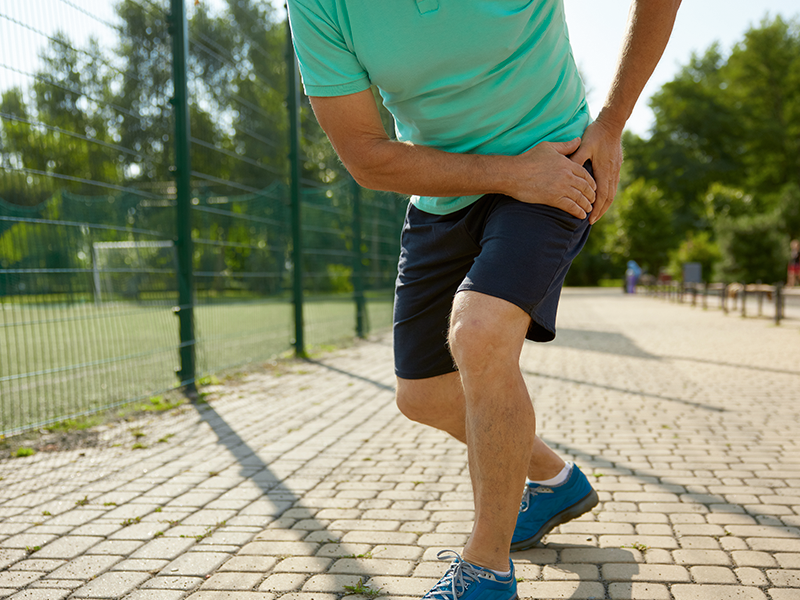Search
Find a Physician
Medically Reviewed by
James P. Moran, DOBlog
Nov 22, 2024
Imagine you’re jogging through the park on a sunny morning, relishing the rhythm of your steps, when suddenly—you hear a faint “pop” in your hip. It’s not the first time you’ve felt it, and the clicking sound follows with every stride. The discomfort builds, making it harder to ignore.
Could it be serious? You shrug it off, hoping it’s just a minor quirk in your movement, but as you go about your day, the sensation lingers, leaving you curious and a little concerned. It could be snapping hip syndrome, a condition that causes telltale “pop” and can lead to pain and inflammation.
Before rushing off to the doctor, it’s helpful to know what snapping hip syndrome really is. This article explores everything you need to know—what causes it, common symptoms, and the treatment options available—to help you understand if it’s time to get that hip checked out.
Snapping hip syndrome is when you feel or hear a “snap” or “pop” in your hip during certain movements. This sound can come from tendons or muscles moving over bones in the hip, especially when lifting or rotating your leg. While it might sound alarming, snapping hip syndrome is usually more annoying than dangerous.
Imagine the tendons around your hip as rubber bands—they glide smoothly most of the time, but occasionally, one might catch or snap over a bone. For some, this is painless; for others, it can lead to discomfort or even pain, especially if it happens frequently.
It’s most common among athletes or dancers whose repetitive hip movements put extra strain on the area. Luckily, there are treatments and exercises to reduce the snapping and ease the strain on your hip, making this a manageable condition for most people.
Snapping hip syndrome can be triggered by several different causes, most of which come down to the way tendons and muscles glide over the bones in the hip. Often, it happens when a tendon or muscle moves over a bony structure, creating that distinctive “snap” or “pop.” One common culprit is the iliotibial (IT) band—a long tendon that runs from the outer upper pelvis down to the outer aspect of the knee. The IT band can snap over the outside of the hip bone (the greater trochanter), especially in people who do repetitive hip movements like runners or dancers.
Another cause might be the hip flexor tendon, which passes over the front of the hip and can snap when the hip is bent or straightened. Sometimes, snapping hip syndrome is also due to structural imbalances or tight muscles that pull on the tendons. Over time, this repetitive snapping can cause irritation and inflammation, especially if left untreated. Luckily, understanding these causes can help guide you toward the right treatment options.
Snapping hip syndrome isn’t a one-size-fits-all condition—there are actually different types, each with distinct causes and sensations.
It's classified as internal or external, depending on where the snapping occurs. These types can vary significantly in both symptoms and how they’re treated. Internal snapping usually involves the front of the hip, while external snapping happens on the outer side.
Understanding the type of snapping hip syndrome you have is important, as it can help you and your healthcare provider find the most effective treatments.
Treating snapping hip syndrome usually starts with simple adjustments and exercises to relieve the stress on your hip. The first step is often rest—taking a break from activities that trigger the snapping can give irritated tendons and muscles a chance to recover.
Stretching and strengthening exercises are also key, particularly ones that target the hip flexors, IT band, and surrounding muscles. These exercises can help reduce tension and improve flexibility, making snapping less likely. These are just some of the most obvious joint health tips, but there are others worth considering.
In some cases, physical therapy is recommended to guide you through specific movements that won’t aggravate the hip. For those with persistent pain, options like anti-inflammatory medications or corticosteroid injections can help manage symptoms. There are a lot of exercises for snapping hip that could help.
Surgery is rarely needed but may be considered if other treatments don’t work. With the right approach, most people find they can manage or even eliminate snapping hip syndrome symptoms and return to regular activities.
Snapping hip syndrome may seem like a minor inconvenience, but it can have a real impact on daily activities and athletic performance if left unaddressed. Understanding the different types - internal and external - is key to identifying the cause and finding the best path to relief.
From rest and targeted exercises to physical therapy and other treatments, plenty of options exist to help manage the condition and prevent it from worsening. If you’re experiencing persistent snapping or discomfort in your hip, taking proactive steps now can make all the difference in maintaining your mobility and comfort long-term.
Take the first step towards relief from snapping hip syndrome—schedule a consultation with our experts at the Orthopedic Institute of NJ today!
This article was reviewed and approved by an orthopedic surgeon as we place a high premium on accuracy for our patients and potential patients.
